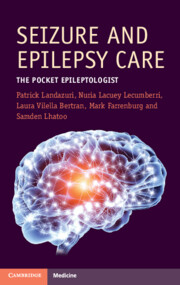Book contents
- Seizure and Epilepsy Care
- Seizure and Epilepsy Care
- Copyright page
- Contents
- 1 How Do I Evaluate a First-Time Seizure?
- 2 How Do I Make an Epilepsy Diagnosis?
- 3 Which Antiseizure Medicines Treat Epilepsy and How Do I Pick?
- 4 How Can I Best Use EEG for Treating Epilepsy Patients?
- 5 What Are Common Epilepsy Imaging Findings in New Onset and Chronic Epilepsy Care?
- 6 How Do I Care for Patients in the Emergency Department and Inpatient Settings?
- 7 How Do I Manage Epilepsy Emergencies Like Status Epilepticus?
- 8 What Is the Best Long-Term Treatment Plan for Epilepsy Patients as an Outpatient?
- 9 What to Do When Your Patient Fails Two Antiseizure Medicines
- 10 Nonepileptic Events and General Psychiatric Care for Epilepsy Patients
- 11 What Are Essential Pediatric Epilepsy Clinical Diagnoses and Treatment Plans?
- Index
- References
11 - What Are Essential Pediatric Epilepsy Clinical Diagnoses and Treatment Plans?
Published online by Cambridge University Press: 28 January 2023
- Seizure and Epilepsy Care
- Seizure and Epilepsy Care
- Copyright page
- Contents
- 1 How Do I Evaluate a First-Time Seizure?
- 2 How Do I Make an Epilepsy Diagnosis?
- 3 Which Antiseizure Medicines Treat Epilepsy and How Do I Pick?
- 4 How Can I Best Use EEG for Treating Epilepsy Patients?
- 5 What Are Common Epilepsy Imaging Findings in New Onset and Chronic Epilepsy Care?
- 6 How Do I Care for Patients in the Emergency Department and Inpatient Settings?
- 7 How Do I Manage Epilepsy Emergencies Like Status Epilepticus?
- 8 What Is the Best Long-Term Treatment Plan for Epilepsy Patients as an Outpatient?
- 9 What to Do When Your Patient Fails Two Antiseizure Medicines
- 10 Nonepileptic Events and General Psychiatric Care for Epilepsy Patients
- 11 What Are Essential Pediatric Epilepsy Clinical Diagnoses and Treatment Plans?
- Index
- References
Summary
Pediatric epilepsy is a broad topic with specific syndromes highlighted in this chapter. A thorough discussion for the evaluation and management of febrile seizures is first. The chapter then transitions to a discussion of high-yield epileptic and developmental encephalopathies. Examples include diagnoses like infantile spasms, Dravet syndrome, and FIRES (febrile infection-related epilepsy syndrome). The chapter than progresses toward the self-limiting epilepsy of childhoods and a discussion of clinical features, management, and long-term prognosis.The generalized epilepsies are then discussed since they commonly commence in the pediatric time period. High-yield EEG examples are provided as they so frequently confirm the diagnosis. Specific neurocutaneous syndromes are next reviewed in a concise table that defines key differences and diagnostic criteria.Lastly, the two diagnoses of Rasmussen’s encephalitis and hemimegaloencephaly that can benefit from early consideration of hemispherectomy are reviewed.
- Type
- Chapter
- Information
- Seizure and Epilepsy CareThe Pocket Epileptologist, pp. 186 - 220Publisher: Cambridge University PressPrint publication year: 2023

